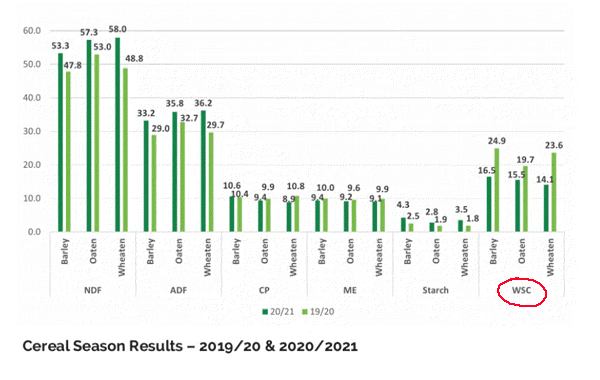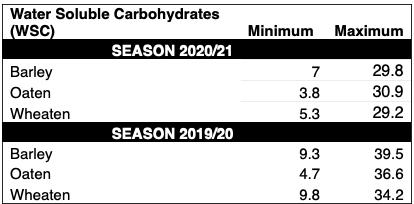
Christine King BVSc, MANZCVS (equine), MVetClinStud
Beware of cereal hays and chaffs
be careful with oaten, wheaten, and barley hay/chaff
Cereal hays include oat ('oaten'), wheat ('wheaten'), and barley. These hays are sold by the bale and they are chopped and sold as chaff for horses, either as plain chaff (e.g., oaten chaff) or in various combinations with each other and with lucerne (e.g., a common "triple chaff" combo contains oaten, wheaten, and lucerne chaff).
Except for lucerne, these plants are all part of the large family of Grasses (Poaceae or Graminae). The cereal subgroup consists of the Grass species that have been carefully cultivated as food crops for humans — i.e., for the production of grain (oats, wheat, barley, corn, rice, sorghum, rye, etc.). Herein lie their upside and their downside...
The upside
Cereals grow in a wide range of geographic areas, and they store well after harvest (when properly dried), so cereal hays/chaffs are widely available throughout the year.
- Although some cereal hays are grown specifically for animal feed (as 'fodder' crops), a significant proportion of the cereal hay on the market is left-over from grain crops and is really more 'straw' (stemmy, yellowed) than hay (leafy, still greenish). The grain market is much bigger and more lucrative than the fodder market. In addition, cattle and small ruminant (sheep and goat) producers often feed cereal hays, which further drives the national hay market toward the production of lucerne and cereal hays rather than grass hays.
In fact, sometimes cereal hays are the only decent-quality hay/chaff available — unless you've made the effort to find a reliable supply of good quality grass hay, which I highly recommend.
- As a counterpoint to these market forces, grasses in general grow in a wide range of geographic areas. Which grass species grow best in a particular area depends on the soil and the climate. But as a broad brushstroke, grasses grow almost anywhere on the planet where temperatures remain above freezing for at least part of the year and there is sufficient rainfall to sustain plant life. In this regard, grasses form the earth's carpet, and there are relatively few areas on the planet that won't grow grasses. As grazing animals such as horses, cattle, and sheep are designed to run on grasses, it's just baffling to me that grass hay makes up such a small part of the national hay market.
It is mostly tradition and the perpetual cycle of consumer demand (customers will continue to buy whatever is available and request what they're used to) that keeps hay growers focused on legume and cereal hays instead of grass hays. But the more horse owners request good quality grass hays of hay growers and feed merchants, the more widely available grass hays will become.
The downside
Their origin as grain crops is also their biggest downside, because cereal hays and chaffs can be too high in sugars for many horses. While small amounts are generally well tolerated, these hays and chaffs can pose serious risk when they are the main or sole forage fed to horses.
- By the way, ruminants (cattle, sheep, goats, etc.) can also have problems with the sugar content of cereal hays and chaffs.
Here is where things get a bit fuzzy, because there is no standard stage of harvest for cereal hays. As a result, the nutritional values for these hays, and chaffs made from them, cover a vast range.
For example, the following graph shows the average nutrient content of three different cereal hays over the past two growing seasons (2019-20 and 2020-21), as reported by the Feed Central feed testing lab in Toowoomba, QLD.

Source: Feed Central newsletter, May 2021
NDF, neutral detergent fibre; ADF, acid detergent fibre; CP, crude protein; ME, metabolisable energy (Mj/kg DM); WSC, water-soluble carbohydrates. Except for ME, all values are percentages, on a 100% dry matter basis (water removed).
I'm particularly interested in the averages for WSC, or water-soluble carbohydrates. These are the most problematic components of pasture grasses and of hays and chaffs in carb-sensitive horses. Water-soluble carbs include the simple sugars, oligosaccharides, and fructans that increase a horse's risk for laminitis, obesity, digestive disorders (colic, diarrhoea), behavioural problems, and exercise-related muscle damage ('tying up'), just to name the most common problems.
As a general rule, carb-sensitive horses need a diet that contains less than 10% WSC. Notice that in both years, the average WSC for all three of these cereal hays was well above 10%. These hays would not be a good choice as the primary forage for carb-sensitive horses.
- Another value that equine nutritionists and vets often talk about is the NSC, or nonstructural carbohydrate, content. The NSC content is easily calculated by adding the values for starch and WSC. For example, the average NSC content for barley hay this past year (2020-21) was 20.8% (4.3% starch + 16.5% WSC). For carb-sensitive horses, we generally advise a total NSC content of less than 15%.
- Unlike the cereal grains themselves (oats, wheat, barley, corn, etc.), which are very high in starch, the cereal hays and chaffs — i.e., the stems and leaves of the cereal plant — are not particularly high in starch, so their WSC content is perhaps the better index of their suitability for carb-sensitive horses.
But those are just the average values. I asked Feed Central to send me the range of WSC values (minimum to maximum) for the samples they tested:

Source: Feed Central, supplied on request.
All values are percentages, on a 100% dry matter basis (water removed).
For each of these cereal hays, the minimum WSC was below the threshold of 10% in both years, although it was close for barley and wheaten hay last year.
More disturbing is the maximum WSC, which ranged from about 29% to almost 40%. These values are 3 to 4 times higher than recommended for carb-sensitive horses.
- FeedTest in Victoria reports even greater ranges for cereal hays in the 2019-20 growing season (currently, their most recent published data):
- Barley hay (344 samples) — average 24% WSC, range 2.4% to 44.8%
- Oaten hay (1,460 samples) — average 24.3% WSC, range 3.0% to 42.3%
- Wheaten hay (1,058 samples) — average 23.4% WSC, range 2.4% to 44.6%
- In other words, cereal hays and chaffs can have a WSC content of close to 45%!
Perhaps the biggest problem is that it's impossible to tell just by looking at a cereal hay or chaff what its WSC content is.
- For example, with barley hay this past year, the WSC ranged from 7% to ~30%, which is more than a 4-fold difference between lowest and highest, and you would not be able to tell just by looking at the hay or chaff where on the spectrum that particular hay/chaff lies.
- And while it may seem from the graph and table that oaten hay/chaff is the safer choice, notice that the WSC values for oaten hay went as high as, or even higher than, those for the other two cereal hays. Oaten hay/chaff is not safer than any other cereal hay; they are all potentially — and equally — problematic, because they are all great unknowns unless and until they are tested.
That goes for most other nutrient values as well, including crude protein. The average crude protein values in the graph above (9–11%) are adequate for the needs of most adult horses who are not pregnant or lactating. But those are just the average values; the minimum values will likely be too low for even the most inactive horse.
- I don't yet have the range of values for crude protein in these cereal hays, but FeedTest in Victoria reported the following crude protein (CP) values for cereal hays in the 2019-20 growing season (currently, their most recent published data):
- Barley hay (344 samples) — average 8.8% CP, range 1.4% to 17.8%
- Oaten hay (1,460 samples) — average 7.6% CP, range 1.5% to 23%
- Wheaten hay (1,058 samples) — average 9% CP, range 1.2% to 22.5%
- At the lower end of these ranges, even an inactive horse would not be able to meet his daily protein needs from these hays (or chaffs made from them). No matter how much he eats of this very low-protein cereal hay, he would still be hungry because he would not be getting enough crude protein to meet even his most basic needs.
- As a point of comparison, good quality grass hays typically have values in the range of 8–12% CP. Even at 8% CP, a good quality grass hay ably meets the daily protein needs for maintenance in adult horses, as long as enough hay is fed.
Test or leave
I'm a big fan of forage testing to determine the nutrient content of pastures and hays. That said, unless you're buying large quantities of cereal hay or chaff, it's generally not cost-effective to test it before you buy or feed it.
If you have a horse who would benefit from a low-WSC diet (which is most of them), it would probably be best to limit or leave the cereal hays and chaffs, and do your best to find some good-quality grass hay instead. The more cereal hay or chaff you feed, the more likely you are to run into problems if that hay/chaff is high in WSC.
- There is at least one hay supplier who sells a grass hay chaff in this region (southeast QLD). Hopefully, others will catch on soon and grass chaff will be as common as lucerne chaff and cereal chaffs.
The more we request good quality grass hays from hay growers and feed merchants, the more consistent the supply will become and the broader the range of options there will be. It may take us a few years to get there, but market forces are powerful things!